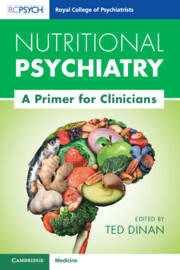Book contents
- Nutritional Psychiatry
- Nutritional Psychiatry
- Copyright page
- Contents
- Contributors
- Preface
- Chapter 1 Basic Principles of Nutrition
- Chapter 2 Diet and the Microbiome–Gut–Brain Axis
- Chapter 3 The Mediterranean Diet and Mental Health
- Chapter 4 Psychobiotics and Fermented Foods
- Chapter 5 Diet Interventions for Anxiety and Depression
- Chapter 6 Schizophrenia, Microbiota and Nutrition
- Chapter 7 Recognising the Importance of Nutrition for Child and Adolescent Mental Health
- Chapter 8 Old Age and Nutrition
- Chapter 9 Broad-Spectrum Micronutrients and Mental Health
- Chapter 10 Epigenetics
- Index
- References
Chapter 7 - Recognising the Importance of Nutrition for Child and Adolescent Mental Health
Published online by Cambridge University Press: 17 August 2023
- Nutritional Psychiatry
- Nutritional Psychiatry
- Copyright page
- Contents
- Contributors
- Preface
- Chapter 1 Basic Principles of Nutrition
- Chapter 2 Diet and the Microbiome–Gut–Brain Axis
- Chapter 3 The Mediterranean Diet and Mental Health
- Chapter 4 Psychobiotics and Fermented Foods
- Chapter 5 Diet Interventions for Anxiety and Depression
- Chapter 6 Schizophrenia, Microbiota and Nutrition
- Chapter 7 Recognising the Importance of Nutrition for Child and Adolescent Mental Health
- Chapter 8 Old Age and Nutrition
- Chapter 9 Broad-Spectrum Micronutrients and Mental Health
- Chapter 10 Epigenetics
- Index
- References
Summary
In recognising the importance of nutrition for child and adolescent mental health, we describe how the gut microbiome is a valuable organ that contains a wealth of potential mechanistic explanations for understanding the development of child and adolescent mental health and as a therapeutic target. The gut microbiome contains trillions of microorganisms that are influenced by not only the food we eat but also the environment in which we live, and this has implications for the functional potential of these microorganisms in sustaining the immune system and metabolic homeostasis. Moreover, a decade of research has shown that there are functional bidirectional pathways linking the gut microbiome and the brain. Herein we postulate that understanding child and adolescent mental health may be advanced by situating research within the conceptual framework of the microbiome–gut–brain (MBA) axis.
To illustrate how the MBA axis can enhance our understanding of the development of mental health, we describe how first milks may set the trajectory for later psychological development and how dietary interventions may prove effective across childhood. Critically, we highlight periods of development in which the gut microbiome may be influential. Finally, we discuss how multidimensional research approaches will be invaluable to further understanding and develop effective treatments for child and adolescent mental health.
- Type
- Chapter
- Information
- Nutritional PsychiatryA Primer for Clinicians, pp. 121 - 133Publisher: Cambridge University PressPrint publication year: 2023



